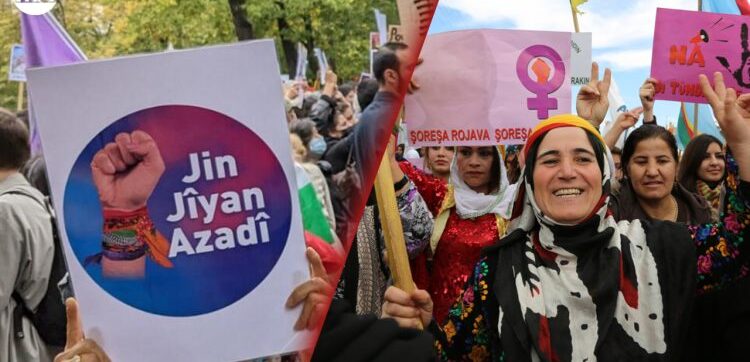Women’s revolution starts with transforming ourselves as individuals and leads to a complete overhaul of society. It’s about building your own identity, challenging men to reshape what it means to be a man, transforming both women and men to create free relationships, and fostering those relationships to build a freer society. It’s a massive, tough, but deeply historic and valuable struggle.
As women, understanding each other is vital. Understanding doesn’t mean blindly accepting everything—it’s about finding common ground and shared truths together. It’s a way to move beyond top-down, imposed ideas. Understanding brings out a flexible, constructive way of communicating and acting. That’s why we need to approach society, and especially women’s realities within it, with philosophy, science, and love—both to understand and to transform.
The third key principle is organisation, which is how the women’s revolution takes shape as a democratic confederal system. But this isn’t just any kind of organisation—it’s about a unique and independent approach to organising. This is a crucial detail. Since we live within society, side by side with dominant male attitudes, we need a distinct and autonomous way of organising. Only through this can women’s freedom, social equality, and justice be achieved. Within the broader revolution, the women’s revolution—and within the wider democratic confederal system, the women’s democratic confederal system—must have its own unique and independent character. Otherwise, it risks being swept away like other revolutions or struggles.
Why the democratic confederal system matters for women
This unique and independent approach doesn’t mean cutting ourselves off from society or the bigger picture. Instead, it’s about protecting our distinct identity while influencing and transforming the wider whole. This identity is rooted in democratic, egalitarian, and freedom-loving values. These qualities define how we organise and build our system. When organisation reflects this spirit, it takes root and grows stronger among women and in society.
Organising a women’s democratic confederal system comes with big challenges but also huge opportunities. The biggest hurdle is that women are often ready to rebel but less prepared for the kind of rebellion that builds something new. Over 5,000 years, women have been stripped of their memory, disconnected from their sources of power—society itself—and left weakened. Women are primed to resist, but building, organising, creating, and systematising? That’s less familiar. Despite women’s incredible creativity and effort, being cut off from their own power has distanced them from the idea and practice of continuously creating their own lives, systems, and struggles. That’s why the women’s revolution is, above all, about awakening awareness and recognising our own strength. We need to deeply define the democratic confederal system, understand why it’s the path to free lives for women, and explain it clearly.
You can’t build a democratic confederal system with outdated mindsets or old methods. The quality of organisation is critical. If it’s not rooted in democratic and freedom-focused values, it risks turning into something rigid, power-hungry, bureaucratic, sexist, or too similar to traditional male-dominated structures. Every organising unit or institution needs to constantly ask: Is this in line with the democratic confederal system? It takes questioning, experimenting, and striving to build it right—over and over again.
Abdullah Öcalan, in his writings from İmralı, outlined the four pillars of the democratic confederal system: communes, assemblies, academies, and cooperatives (or communal economies). These are brought to life through organic connections with people and women, rooted in grassroots decision-making. It’s like flipping a pyramid upside down—where the base, the smallest units, hold the power to make decisions about life and govern themselves. For women’s confederal systems, this means women’s communes, assemblies, academies, and communal economies, all developed with women at the centre and coordinated through a confederal network.
How communes and diversity can be organised
Communes can be incredibly diverse. Think sports communes, children’s communes, family communes, economic or ecological ones, or even reading and writing groups—flexible and varied. Assemblies, too, can be spaces where every unique voice is heard and expressed. Through direct democracy, they’re woven into a coordinated system with real decision-making power. Places like Rojava, Şengal, Maxmur, and parts of Europe show this in practice for women. It’s not just theory—though it’s not perfect, it’s a lived reality. By critiquing and improving its flaws, it’s evolving toward its best and most effective form.
The key is that these units—communes and assemblies—must be organised entirely around women’s needs for freedom and equality. They should be strongholds for challenging male dominance and driving the democratic transformation of society, families and men themselves.
Another core aim of democratic confederal organisation is to overcome society’s fragmentation and create unity. It needs to be flexible enough to include everyone. The goal is to bring all parts of society into the system, making everyone active and involved. Women, with their inclusive and open-minded nature, are especially suited to uniting diverse identities—like Kurds, Arabs, Armenians, Assyrians, Circassians, Turkmen, Laz and others—around democracy, freedom, and equality. The more diversity comes together, the richer and freer the outcome. This calls for education and awareness to deepen and strengthen shared living.
In this system, leadership doesn’t override the decision-making bodies. The real power lies in the direct democratic processes—communes and assemblies—where decisions are made. Leadership’s role is to carry out those decisions and coordinate between units, not to dictate or decide on their own. They’re accountable, and the units can remove them if needed. This is the heart of self-governance: women managing themselves through shared decisions. Anything less risks slipping into top-down, bureaucratic systems that breed power and control.
A global vision for women’s struggle
Another vital aspect is the system’s potential to go global. The more an organisation builds local, regional, and international networks, the more influence and staying power it has. The democratic confederal system’s openness to flexible, far-reaching organisation offers women a powerful opportunity. It enables a unified women’s struggle against global male-dominated systems, creating shared policies and agendas that make a real impact.
The fourth principle is struggle itself—how and where the women’s confederal system fights. Women’s revolution can be defined as a relentless, multifaceted battle against power structures and male dominance. Women have been enslaved in every sphere—ideologically, politically, militarily, socially, sexually, culturally, economically, legally. Breaking free requires an equally broad fight. We can’t focus on one area and ignore the rest; we need a holistic, interconnected approach to dismantle the many layers of oppression.
Women’s revolution as social transformation
Communes and assemblies are the frontlines of this struggle, while areas like education, economy, health, self-defence, ecology, law, culture, arts, diplomacy, and politics are both battlegrounds and spaces to build free lives. This system doesn’t just critique or expose male dominance—it fights by creating alternatives through organisation and action. It’s not about simple opposition or rebellion but about building, overcoming, and offering new ways forward.
This approach is inclusive, drawing everyone in and inspiring action. It aims to transform society from the ground up, starting with women. It involves a constant ideological battle against the flaws in both women and men—their dominant or submissive traits. This fight, often called the gender struggle, is non-negotiable. It’s about creating free women’s identities and personalities, a historic mission. It’s a revolution that starts with individual transformation and leads to a freer society—a complex, challenging, but profoundly meaningful journey.

